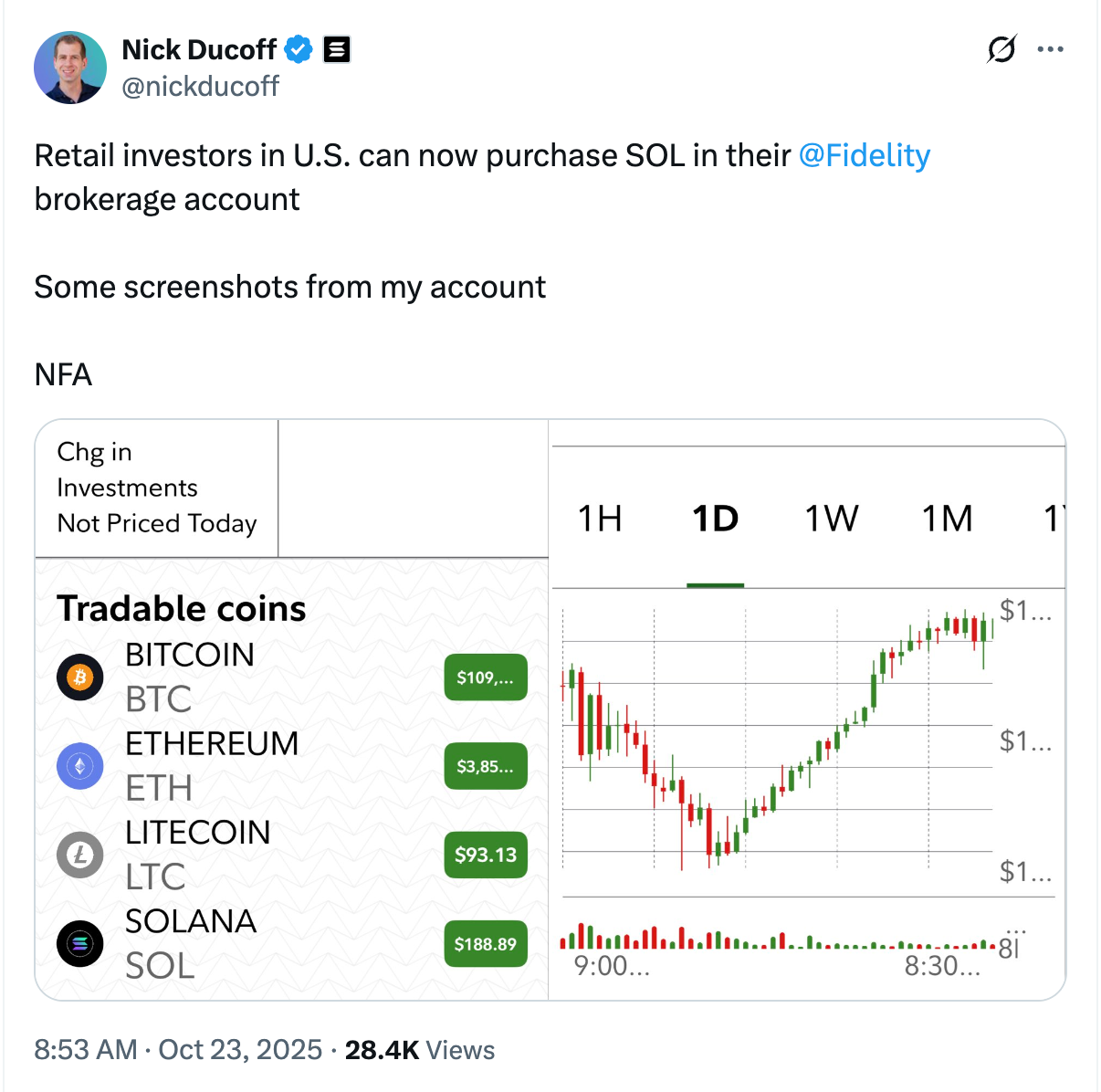Fidelity has integrated Solana (SOL) trading into its platforms, enabling institutional and retail clients to buy, sell, and trade the token. This move highlights growing institutional adoption of Solana as a high-speed blockchain for digital assets, bridging traditional finance with crypto markets.
-
Solana trading now available on Fidelity Crypto, IRAs, wealth management, and institutional platforms.
-
This addition supports Fidelity’s long-term strategy for digital asset infrastructure, similar to traditional investments.
-
Solana’s market cap exceeds $104 billion, ranking it as the sixth-largest cryptocurrency by capitalization, per CoinMarketCap data.
Discover how Fidelity’s addition of Solana trading opens new doors for investors. Explore SOL’s role in internet capital markets and tokenized assets for enhanced liquidity. Stay ahead in crypto—read more now!
How Does Fidelity’s Solana Trading Integration Benefit Investors?
Fidelity Solana trading allows clients to access the SOL token directly through multiple Fidelity platforms, including retail crypto services and institutional digital asset solutions. This integration provides seamless buying, selling, and trading options, reducing barriers for both institutional and individual investors entering the Solana ecosystem. By incorporating SOL, Fidelity underscores the maturation of cryptocurrencies as a legitimate asset class, aligning digital finance more closely with established markets.
What Makes Solana Attractive for Institutional Adoption?
Solana stands out due to its high throughput and low transaction costs, processing thousands of transactions per second while maintaining scalability for decentralized applications. A spokesperson for Fidelity noted that this addition continues the company’s efforts to build robust infrastructure for digital assets, akin to its offerings for traditional securities. According to data from CoinMarketCap, SOL holds a market capitalization over $104 billion, positioning it as the sixth-largest cryptocurrency. This growth reflects increasing confidence from institutions, as Solana’s network supports innovative use cases like decentralized finance and non-fungible tokens.
The Solana community’s developers emphasize its potential to become the epicenter of internet capital markets, competing with traditional Wall Street systems. They envision Solana hosting a wide array of tokenized real-world assets (RWAs), such as stocks, bonds, money market funds, stablecoins, and even collectibles. This tokenization process aims to democratize access to financial instruments, making them available 24/7 and unlocking liquidity in assets that were previously illiquid. For instance, the launch of crosschain interoperable versions of Tether’s USDT stablecoin and XAUT tokenized gold on Solana in October has bolstered its role as a liquidity hub for stablecoins across blockchains.
Experts in the blockchain space, including those from the Solana Foundation, highlight how these developments could transform decentralized finance (DeFi). By providing deeper stablecoin liquidity, Solana reduces risks like volatility spikes, depegging events, and slippage during trades. This infrastructure positions the network as a foundational layer for global, always-on financial services. In parallel, regulatory shifts in the United States are supporting this evolution; in September, the Securities and Exchange Commission (SEC) and the Commodity Futures Trading Commission (CFTC) issued a joint statement advocating for extended trading hours. They stated, “Further expanding trading hours could better align US markets with the evolving reality of a global, always-on economy,” signaling a move toward round-the-clock operations that eliminate closures on nights, weekends, and holidays.
Fidelity’s decision to add Solana trading arrives at a pivotal moment for the cryptocurrency industry. The platform now supports SOL across Fidelity Crypto for everyday users, Fidelity Crypto for IRAs to facilitate retirement savings in digital assets, Fidelity Crypto for Wealth Managers to serve high-net-worth clients, and Fidelity Digital Assets for institutional-scale operations. This comprehensive rollout ensures that investors of all levels can participate in Solana’s ecosystem without needing to switch providers.
From an institutional perspective, Solana’s appeal lies in its technical robustness. The blockchain uses a unique proof-of-history consensus mechanism combined with proof-of-stake, enabling faster and more efficient processing than many competitors. This has attracted major developers and projects, fostering an environment ripe for innovation. Tokenized RWAs on Solana not only enhance accessibility but also introduce new revenue streams; for example, stablecoins like USDT provide a stable medium of exchange, while assets like XAUT offer exposure to commodities like gold in a digital format.
As institutional interest grows, Solana is increasingly viewed as a bridge between legacy finance and blockchain technology. Fidelity’s integration exemplifies how established financial giants are adapting to crypto’s rise, offering clients diversified portfolios that include high-growth assets like SOL. Market analysts point to Solana’s resilience amid broader crypto volatility, with its market cap demonstrating sustained investor confidence.
The broader implications for the crypto market are significant. With Solana positioning itself as the home for internet capital markets, it could facilitate seamless tokenization of trillions in real-world value. This vision includes everything from fractional ownership of real estate to instant settlement of securities trades. Developers within the Solana ecosystem are actively building tools to support this, such as advanced smart contracts and interoperability protocols that connect Solana to other blockchains.
Regulatory alignment is another key factor. The SEC and CFTC’s push for 24/7 markets aligns perfectly with blockchain’s inherent availability, potentially accelerating adoption. As these changes unfold, platforms like Fidelity are at the forefront, providing the educational resources and secure trading environments needed for widespread participation.
Fidelity, a financial services company, has added Solana trading to its platform, making the network’s native token available to both institutional and retail clients.
Solana (SOL) is now available to buy, sell, and trade on Fidelity Crypto, Fidelity Crypto for IRAs, Fidelity Crypto for Wealth Managers, and Fidelity Digital Assets’ platform for institutional investors, a spokesperson confirmed to Cointelegraph on Thursday. The spokesperson added:
“The addition of Solana is a continuation of Fidelity’s decade-plus effort to develop the infrastructure, products, and educational resources for digital assets consistent with the solutions we provide for traditional asset classes.”
The added support for SOL signals that cryptocurrencies are maturing as an asset class, further reducing the gap between legacy and digital finance.

Source: Nick Ducoff
The addition of SOL comes amid growing institutional interest in the Solana network, as the community positions it as the hub of internet capital markets.
Solana wants to rival Wall Street by becoming the home of internet capital markets
SOL has a market capitalization of over $104 billion and is the sixth-largest crypto by market capitalization as of this writing, according to CoinMarketCap.
Key developers within the Solana community say the network still has room for significant growth and aim to make it the home of internet capital markets, rivaling Wall Street.
Solana developers want the blockchain to host tokenized real-world assets (RWAs), including stocks, money market funds, stablecoins, and collectibles, thereby democratizing access to finance and unlocking liquidity trapped in traditionally illiquid asset classes.
Crosschain interoperable versions of Tether’s dollar-pegged stablecoin USDt (USDT) and Tether Gold (XAUT), a tokenized gold product, launched on Solana in October, potentially positioning the network as a cross-chain stablecoin liquidity hub.
The addition of these tokenized RWAs on Solana could make the network a central piece of decentralized finance (DeFi) infrastructure, allowing traders access to deeper stablecoin liquidity and reducing the chance of high volatility, depegging, and trade slippage.
In September, regulators in the United States signaled their intent to overhaul the legacy financial system, which closes on nights, weekends, and holidays, pivoting to a 24/7 trading schedule.
“Further expanding trading hours could better align US markets with the evolving reality of a global, always-on economy,” spokespeople for the Securities and Exchange Commission (SEC) and the Commodity Futures Trading Commission said in a joint statement.
Frequently Asked Questions
What Platforms Support Fidelity Solana Trading?
Fidelity Solana trading is accessible via Fidelity Crypto for retail users, Fidelity Crypto for IRAs for retirement accounts, Fidelity Crypto for Wealth Managers for advisory services, and Fidelity Digital Assets for institutional clients. This multi-tiered approach ensures broad availability, with secure and compliant trading options tailored to different investor needs.
Why Is Solana Gaining Traction Among Institutions Like Fidelity?
Solana’s high-speed blockchain and low fees make it ideal for scalable applications in DeFi and tokenized assets. Institutions value its efficiency in handling real-world assets like stablecoins, which provide stability and liquidity in volatile markets, as evidenced by recent launches of USDT and XAUT on the network.
Key Takeaways
- Institutional Bridge: Fidelity’s Solana integration marks a key step in merging traditional finance with blockchain, offering clients direct access to SOL trading.
- Market Growth: With a $104 billion market cap, Solana’s position as the sixth-largest crypto underscores its rising prominence in digital assets.
- Future Vision: Focus on tokenized RWAs and 24/7 markets positions Solana to democratize finance—consider exploring SOL for portfolio diversification.
Conclusion
Fidelity’s addition of Solana trading represents a milestone in the evolution of Solana as internet capital markets hub, enhancing accessibility to high-performance blockchain assets for investors worldwide. As tokenized real-world assets and stablecoins proliferate on Solana, the network is poised to unlock new liquidity and efficiency in global finance. Looking ahead, this integration encourages broader adoption—investors should monitor regulatory developments and Solana’s ecosystem growth to capitalize on emerging opportunities.
